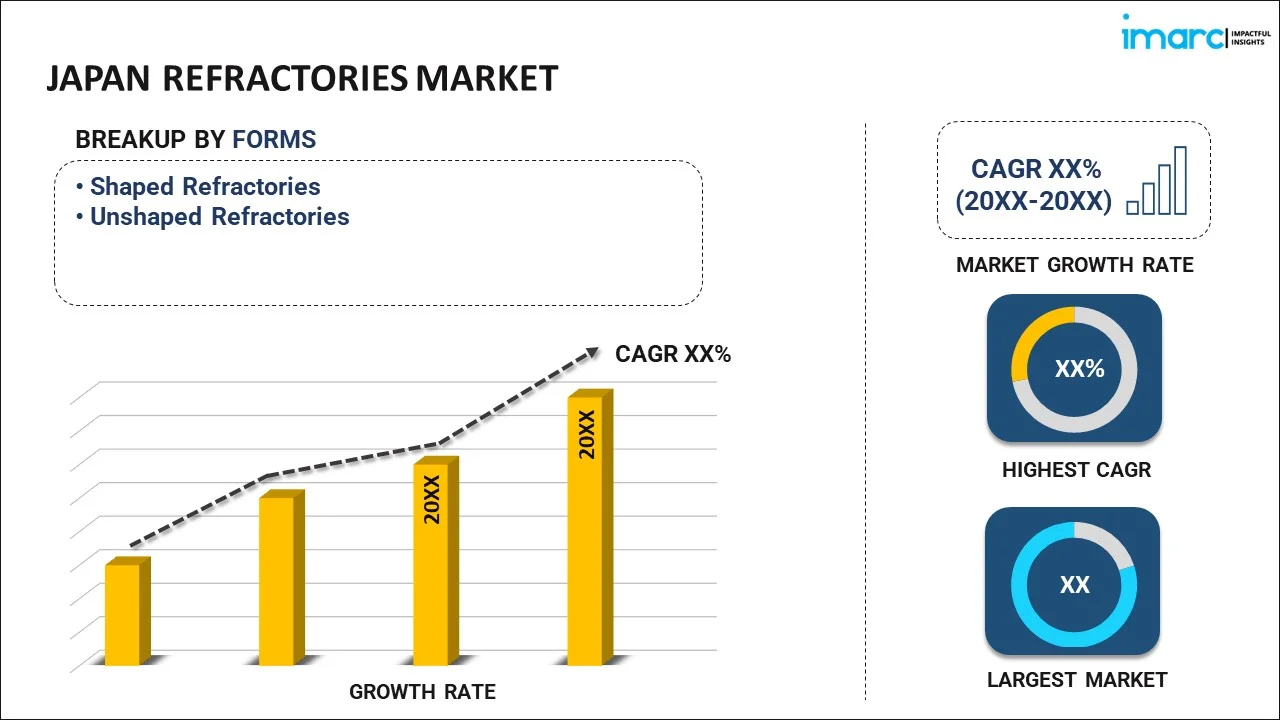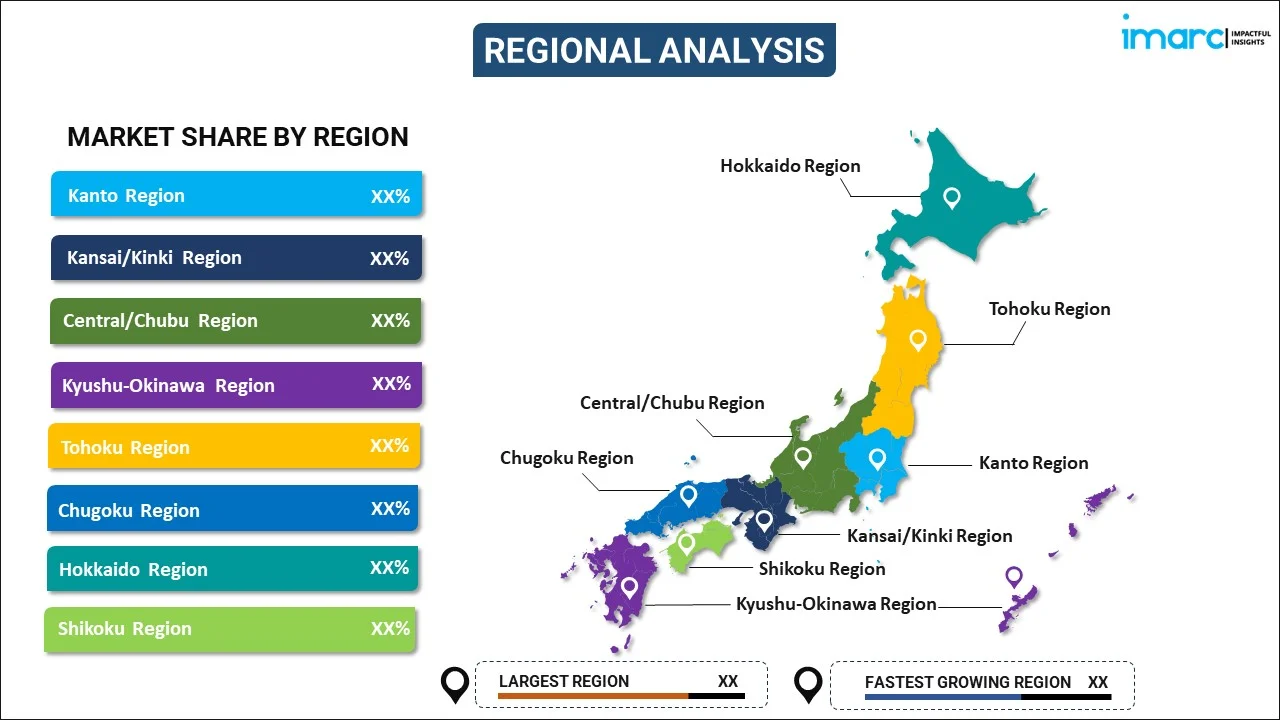
Japan Refractories Market Report by Form (Shaped Refractories, Unshaped Refractories), Alkalinity (Acidic and Neutral, Basic), Manufacturing Process (Dry Press Process, Fused Cast, Hand Molded, Formed, Unformed), Composition (Clay-Based, Nonclay-Based), Refractory Mineral (Graphite, Magnesite, Chromite, Silica, High Alumina, Zirconia, and Others), Application (Iron and Steel, Cement, Non-Ferrous Metals, Glass, and Others), and Region 2025-2033
Market Overview:
Japan refractories market size reached USD 1.2 Billion in 2024. Looking forward, IMARC Group expects the market to reach USD 1.7 Billion by 2033, exhibiting a growth rate (CAGR) of 3.52% during 2025-2033. Rapid industrialization, increasing environmental regulations, the rising advancements in refractory technology and product innovation, the growing use of refractories in non-traditional applications, and the recovery and growth of the metal and mining industries are some of the factors propelling the market.
|
Report Attribute
|
Key Statistics
|
|---|---|
|
Base Year
|
2024
|
|
Forecast Years
|
2025-2033
|
|
Historical Years
|
2019-2024
|
| Market Size in 2024 | USD 1.2 Billion |
| Market Forecast in 2033 | USD 1.7 Billion |
| Market Growth Rate 2025-2033 | 3.52% |
Refractories, crucial components in high-temperature industrial processes, are specialized materials designed to withstand extreme heat, mechanical stress, and chemical erosion. Composed of ceramics, minerals, and other heat-resistant substances, refractories are pivotal in steel, cement, glass, and petrochemicals. Their primary function is to line furnaces, kilns, and reactors, providing a protective barrier against the harsh conditions encountered during manufacturing. The manufacturing of refractories involves careful selection and blending of raw materials, followed by shaping and firing at high temperatures to impart the desired strength and heat resistance. With applications ranging from lining blast furnaces in steel production to insulating kilns in ceramics manufacturing, refractories ensure the structural integrity of industrial equipment and facilitate efficient, controlled, high-temperature operations. As industries continue to push the boundaries of thermal processes, the demand for advanced refractories with enhanced durability, thermal conductivity, and resistance to chemical corrosion remains a driving force, positioning these materials as indispensable contributors to the longevity and efficiency of high-temperature operations across diverse sectors.
Japan Refractories Market Trends:
The market in Japan is majorly driven by the rapid technological advancements. In line with this, the country's prominence in the global steel industry is positively influencing the market. Furthermore, with a substantial presence of steel manufacturing facilities, the need for high-quality refractory materials is vital to ensure the durability and efficiency of furnaces and other equipment in the production process. As Japan continually invests in modernizing and optimizing its steel production capabilities, the demand for advanced refractories that withstand extreme temperatures and provide superior thermal insulation remains steadfast. Besides, the country's commitment to energy efficiency and environmental sustainability propels the demand for refractories in industries such as cement and glass manufacturing. Japan's stringent environmental regulations and focus on reducing carbon emissions drive industries to adopt innovative technologies and materials, including advanced refractories that enhance energy efficiency in kilns and reduce environmental impact. Additionally, the growing emphasis on infrastructure development and reconstruction projects further stimulates the market, as refractories are integral to the construction and maintenance of high-temperature processing units. Moreover, the country's leadership in electronics and technology necessitates refractories for producing semiconductor materials. The semiconductor industry's demand for precise and controlled high-temperature processes, such as silicon wafers, underscores the importance of specialized refractories in supporting these critical manufacturing operations. As Japan continues to be at the forefront of technological innovation, the market for refractories is poised to benefit from the constant need for materials that can withstand the intricate and demanding requirements of cutting-edge electronic manufacturing processes.
Japan Refractories Market Segmentation:
IMARC Group provides an analysis of the key trends in each segment of the market, along with forecasts at the country level for 2025-2033. our report has categorized the market based on form, alkalinity, manufacturing process, composition, refractory mineral, and application.
Form Insights:

- Shaped Refractories
- Unshaped Refractories
The report has provided a detailed breakup and analysis of the market based on the form. This includes shaped refractories and unshaped refractories.
Alkalinity Insights:
- Acidic and Neutral
- Basic
A detailed breakup and analysis of the market based on the alkalinity have also been provided in the report. This includes acidic and neutral and basic.
Manufacturing Process Insights:
- Dry Press Process
- Fused Cast
- Hand Molded
- Formed
- Unformed
The report has provided a detailed breakup and analysis of the market based on the manufacturing process. This includes dry press process, fused cast, hand molded, formed, and unformed.
Composition Insights:
- Clay-Based
- Nonclay-Based
A detailed breakup and analysis of the market based on the composition have also been provided in the report. This includes clay-based and nonclay-based.
Refractory Mineral Insights:
- Graphite
- Magnesite
- Chromite
- Silica
- High Alumina
- Zirconia
- Others
The report has provided a detailed breakup and analysis of the market based on refractory mineral. This includes graphite, magnesite, chromite, silica, high alumina, zirconia, and others.
Application Insights:
- Iron and Steel
- Cement
- Non-Ferrous Metals
- Glass
- Others
A detailed breakup and analysis of the market based on the application have also been provided in the report. This includes iron and steel, cement, non-ferrous metals, glass, and others.
Regional Insights:

- Kanto Region
- Kansai/Kinki Region
- Central/ Chubu Region
- Kyushu-Okinawa Region
- Tohoku Region
- Chugoku Region
- Hokkaido Region
- Shikoku Region
The report has also provided a comprehensive analysis of all the major regional markets, which include Kanto Region, Kansai/Kinki Region, Central/ Chubu Region, Kyushu-Okinawa Region, Tohoku Region, Chugoku Region, Hokkaido Region, and Shikoku Region.
Competitive Landscape:
The market research report has also provided a comprehensive analysis of the competitive landscape. Competitive analysis such as market structure, key player positioning, top winning strategies, competitive dashboard, and company evaluation quadrant has been covered in the report. Also, detailed profiles of all major companies have been provided. Some of the key players include:
- Krosaki Harima Corporation.
- Rozai Kogyo Kaisha, Ltd.
- Shinagawa Refractories Co., Ltd.
- TAIKO refractories CO., LTD.
- TYK Corporation
- Yotai Refractories Co., Ltd.
(Please note that this is only a partial list of the key players, and the complete list is provided in the report.)
Japan Refractories Market Report Coverage:
| Report Features | Details |
|---|---|
| Base Year of the Analysis | 2024 |
| Historical Period | 2019-2024 |
| Forecast Period | 2025-2033 |
| Units | Billion USD |
| Scope of the Report | Exploration of Historical Trends and Market Outlook, Industry Catalysts and Challenges, Segment-Wise Historical and Future Market Assessment:
|
| Forms Covered | Shaped Refractories, Unshaped Refractories |
| Alkalinities Covered | Acidic and Neutral, Basic |
| Manufacturing Processes Covered | Dry Press Process, Fused Cast, Hand Molded, Formed, Unformed |
| Compositions Covered | Clay-Based, Nonclay-Based |
| Refractory Minerals Covered | Graphite, Magnesite, Chromite, Silica, High Alumina, Zirconia, Others |
| Applications Covered | Iron and Steel, Cement, Non-Ferrous Metals, Glass, Others |
| Regions Covered | Kanto Region, Kansai/Kinki Region, Central/ Chubu Region, Kyushu-Okinawa Region, Tohoku Region, Chugoku Region, Hokkaido Region, Shikoku Region |
| Companies Covered | Krosaki Harima Corporation., Rozai Kogyo Kaisha, Ltd., Shinagawa Refractories Co., Ltd., TAIKO refractories CO., LTD., TYK Corporation, Yotai Refractories Co., Ltd., etc. |
| Customization Scope | 10% Free Customization |
| Post-Sale Analyst Support | 10-12 Weeks |
| Delivery Format | PDF and Excel through Email (We can also provide the editable version of the report in PPT/Word format on special request) |
Key Questions Answered in This Report:
- How has the Japan refractories market performed so far and how will it perform in the coming years?
- What has been the impact of COVID-19 on the Japan refractories market?
- What is the breakup of the Japan refractories market on the basis of form?
- What is the breakup of the Japan Refractories market on the basis of alkalinity?
- What is the breakup of the Japan refractories market on the basis of manufacturing process?
- What is the breakup of the Japan refractories market on the basis of composition?
- What is the breakup of the Japan refractories market on the basis of refractory mineral?
- What is the breakup of the Japan refractories market on the basis of application?
- What are the various stages in the value chain of the Japan refractories market?
- What are the key driving factors and challenges in the Japan refractories?
- What is the structure of the Japan refractories market and who are the key players?
- What is the degree of competition in the Japan refractories market?
Key Benefits for Stakeholders:
- IMARC’s industry report offers a comprehensive quantitative analysis of various market segments, historical and current market trends, market forecasts, and dynamics of the Japan refractories market from 2019-2033.
- The research report provides the latest information on the market drivers, challenges, and opportunities in the Japan refractories market.
- Porter's five forces analysis assist stakeholders in assessing the impact of new entrants, competitive rivalry, supplier power, buyer power, and the threat of substitution. It helps stakeholders to analyze the level of competition within the Japan refractories industry and its attractiveness.
- Competitive landscape allows stakeholders to understand their competitive environment and provides an insight into the current positions of key players in the market.
Need more help?
- Speak to our experienced analysts for insights on the current market scenarios.
- Include additional segments and countries to customize the report as per your requirement.
- Gain an unparalleled competitive advantage in your domain by understanding how to utilize the report and positively impacting your operations and revenue.
- For further assistance, please connect with our analysts.
 Inquire Before Buying
Inquire Before Buying
 Speak to an Analyst
Speak to an Analyst
 Request Brochure
Request Brochure
 Request Customization
Request Customization




.webp)




.webp)












